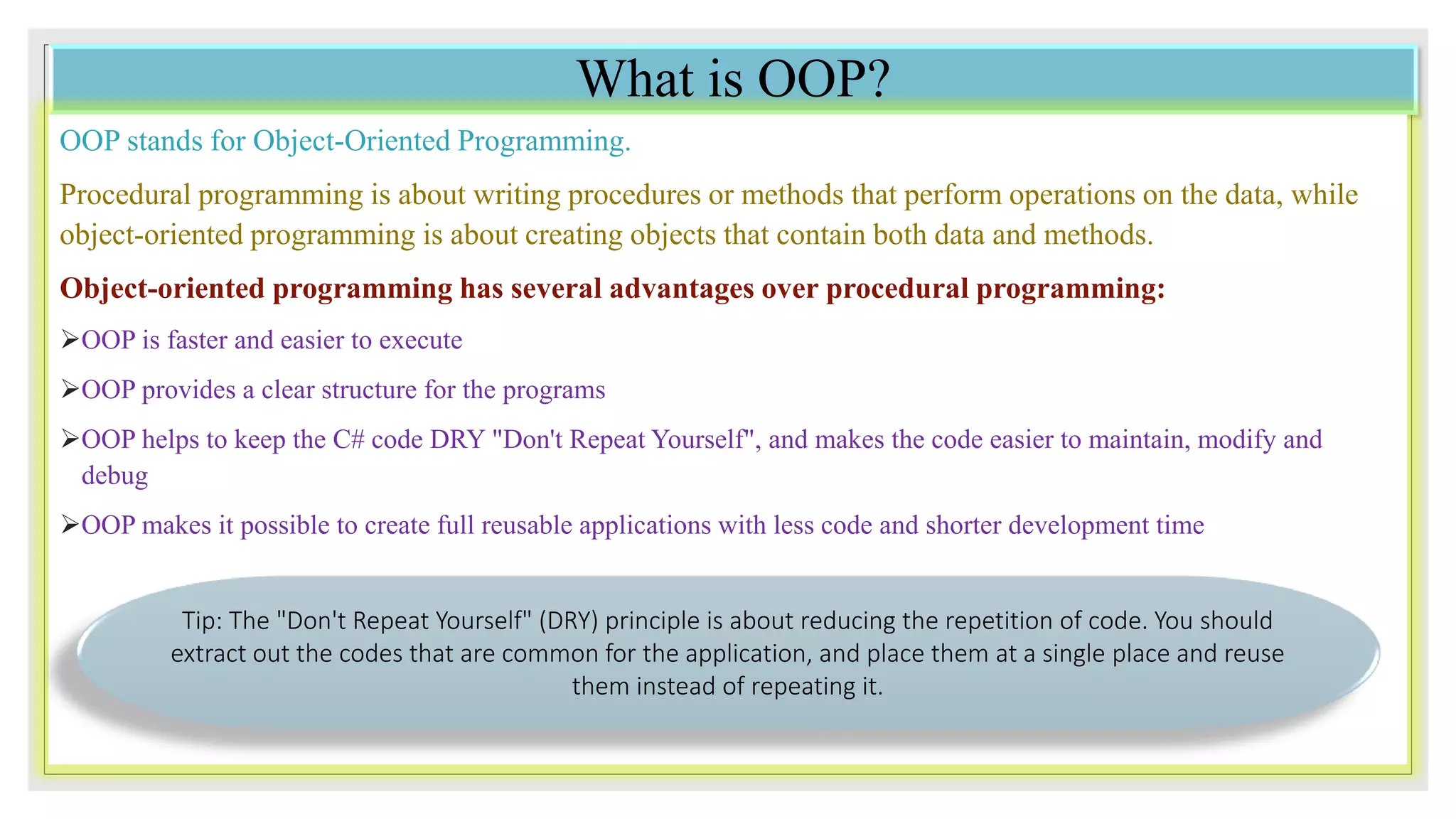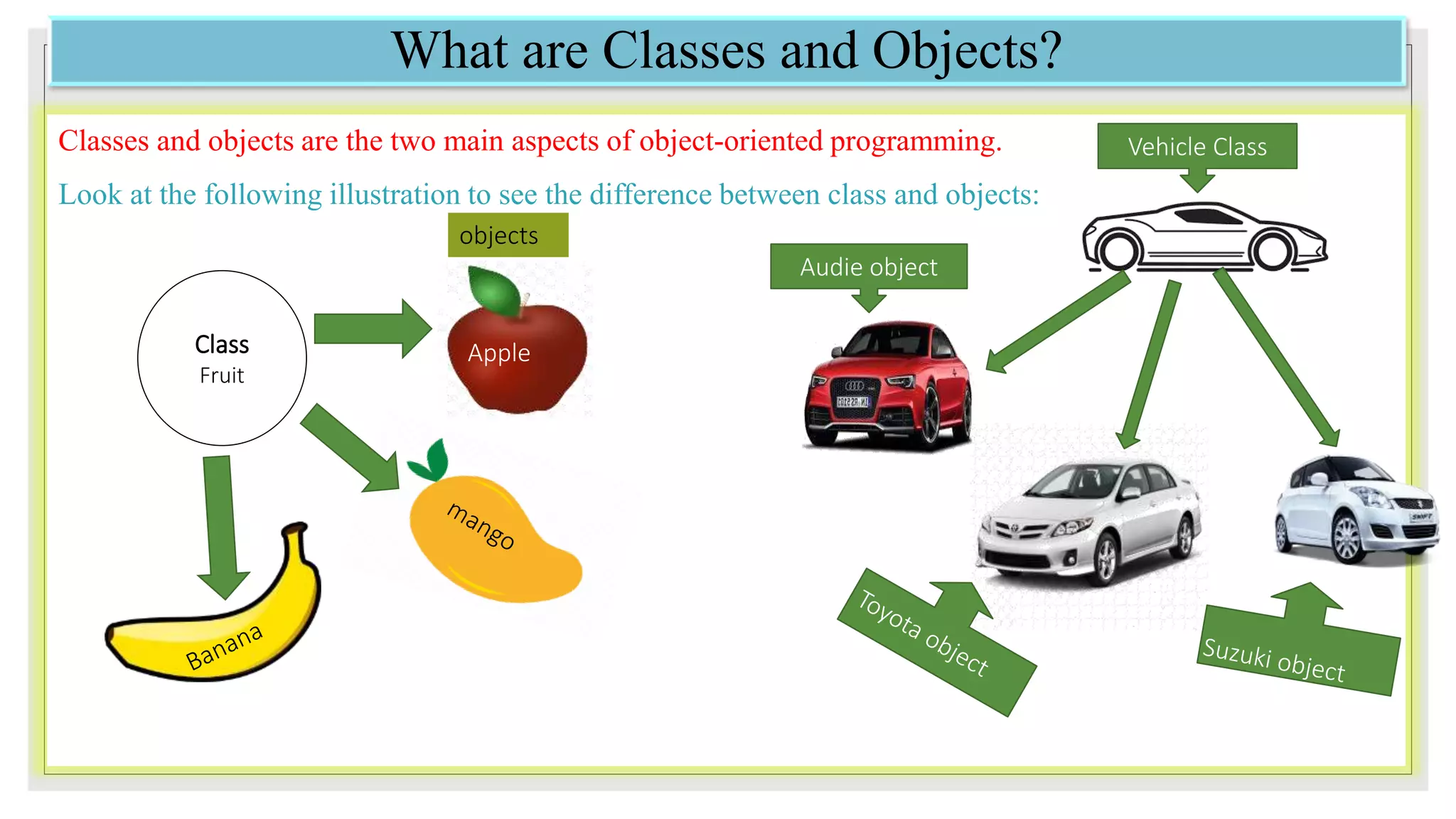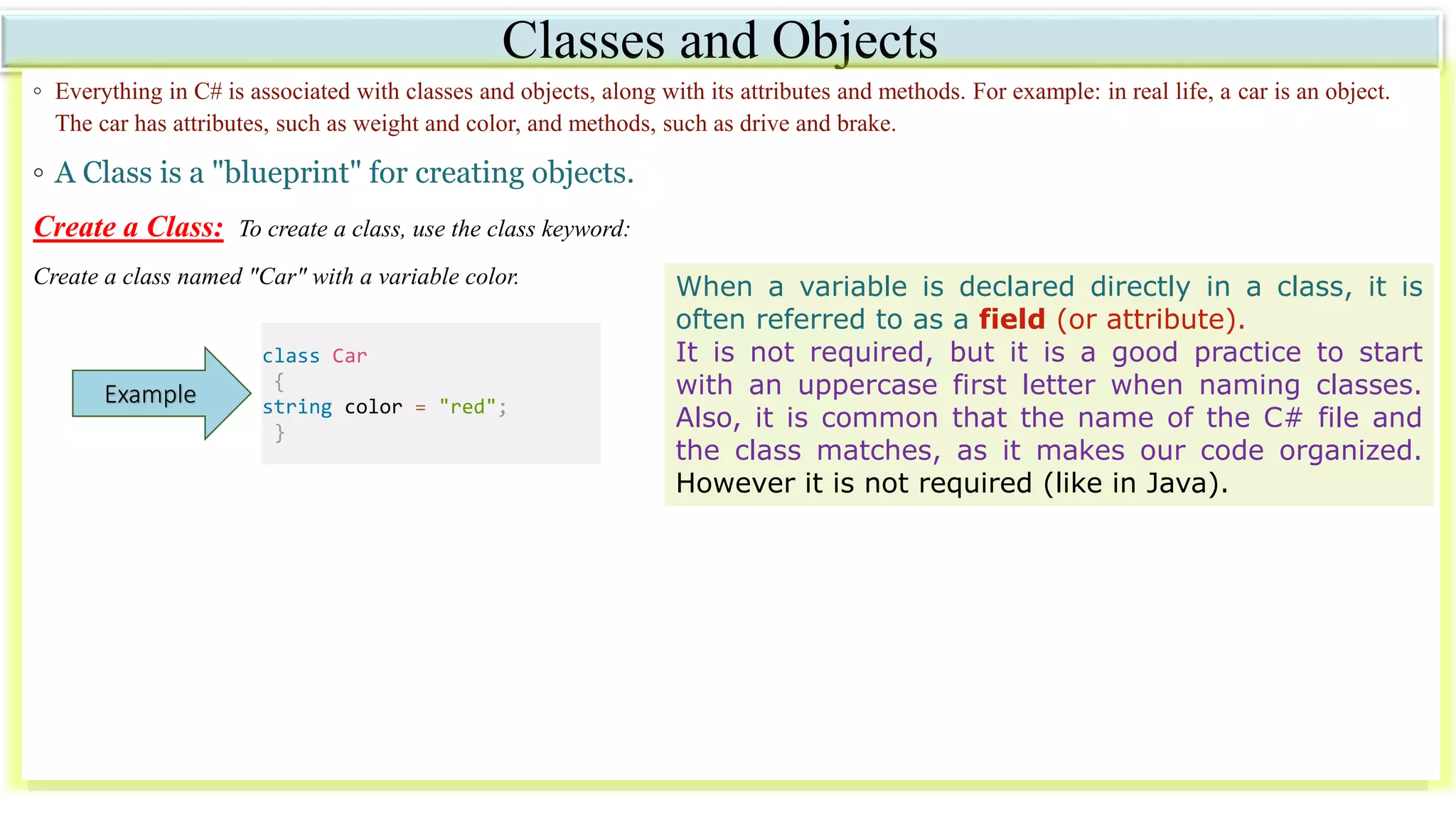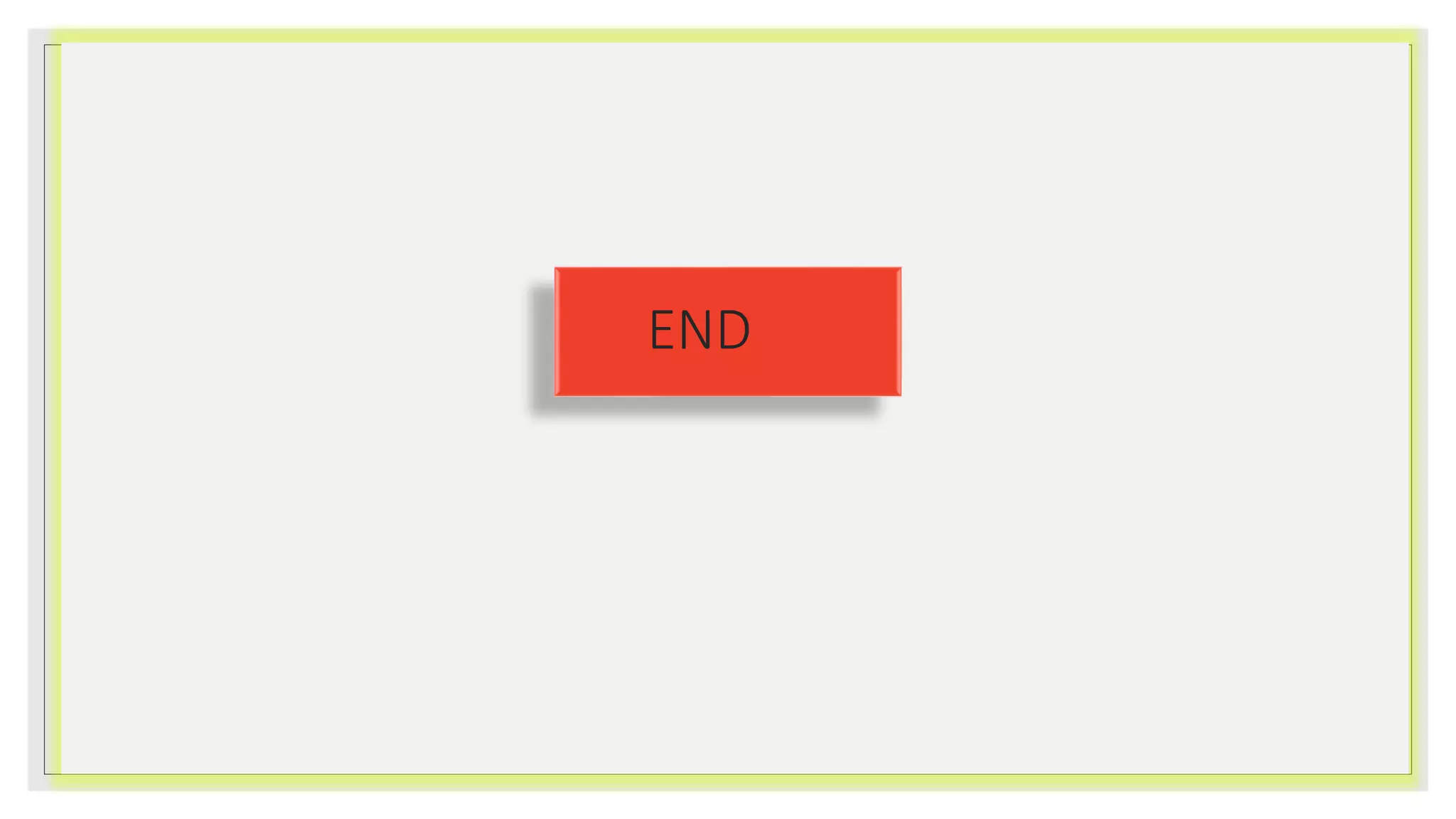This document introduces object-oriented programming (OOP) in C#, highlighting its advantages over procedural programming, such as improved code maintainability and efficiency. It explains the concepts of classes and objects, detailing how classes serve as templates for creating objects and how objects can encapsulate attributes and methods. Furthermore, the document includes examples of creating classes and objects, accessing their members, and the importance of the public access modifier for class members.





![Create an Object
An object is created from a class. We have already created the class named Car, so now we can use this to create objects.
To create an object of Car, specify the class name, followed by the object name, and use the keyword new:
Example:
Create an object called "myObj" and use it to print the value of color:Example
class Car
{
string color = "red";
static void Main(string[] args)
{
Car myObj = new Car();
Console.WriteLine(myObj.color);
}
}
Note that we use the dot syntax (.) to access
variables/fields inside a class (myObj.color). You will
learn more about fields in the next chapter.
You can create multiple objects
of one class:
class Car
{
string color = "red";
static void Main(string[] args)
{
Car myObj1 = new Car();
Car myObj2 = new Car();
Console.WriteLine(myObj1.color);
Console.WriteLine(myObj2.color);
}
}](https://image.slidesharecdn.com/clecture9classes-201217174422/75/OOP-in-C-Classes-and-Objects-6-2048.jpg)
![Using Multiple Classes
You can also create an object of a class and access it in another class. This is often used for better organization of classes (one class has all the
fields and methods, while the other class holds the Main() method (code to be executed)).
Example
Did you notice the public keyword? It is
called an access modifier, which specifies
that the color variable/field of Car is
accessible for other classes as well, such as
Program.
Class calling car class object
class Car
{
public string color = "red";
}
class Program
{
static void Main(string[] args)
{
Car myObj = new Car();
Console.WriteLine(myObj.color);
}
}](https://image.slidesharecdn.com/clecture9classes-201217174422/75/OOP-in-C-Classes-and-Objects-7-2048.jpg)
![Class Members
Fields and methods inside classes are often referred to as "Class Members":
Create a Car class with three class members: two fields and one method.
Example
// The class
class MyClass
{
// Class members
string color = "red";// field
int maxSpeed = 200;// field
public void fullThrottle() // method
{
Console.WriteLine("The car is going as fast as it can!");
}
}
In the previous chapter, you learned that variables inside a class are called fields, and
that you can access them by creating an object of the class, and by using the
dot syntax (.).
The following example will create an object of the Car class, with the name myObj.
Then we print the value of the fields color and maxSpeed:
Fields
class Car
{
string color = "red";
int maxSpeed = 200;
static void Main(string[] args)
{
Car myObj = new Car();
Console.WriteLine(myObj.color);
Console.WriteLine(myObj.maxSpeed);
}
}](https://image.slidesharecdn.com/clecture9classes-201217174422/75/OOP-in-C-Classes-and-Objects-8-2048.jpg)
![Example with blank fields
class Car
{
string model;
string color;
int year;
static void Main(string[] args)
{
Car Ford = new Car();
Ford.model = "Mustang";
Ford.color = "red";
Ford.year = 1969;
Car Opel = new Car();
Opel.model = "Astra";
Opel.color = "white";
Opel.year = 2005;
Console.WriteLine(Ford.model);
Console.WriteLine(Opel.model);
}
}](https://image.slidesharecdn.com/clecture9classes-201217174422/75/OOP-in-C-Classes-and-Objects-9-2048.jpg)
![Object Methods
Methods normally belongs to a class, and they define how an object of a class behaves.
Just like with fields, you can access methods with the dot syntax. However, note that the method must be public. And remember that we use
the name of the method followed by two parentheses ( ) and a semicolon ; to call (execute) the method:
Why did we declare the method as public, and not
static, like in the examples from the C# Methods
Chapter?
The reason is simple: a static method can be accessed
without creating an object of the class, while public
methods can only be accessed by objects.
class Car
{
string color; // field
int maxSpeed; // field
public void fullThrottle() // method
{
Console.WriteLine("The car is going as fast as it can!");
}
static void Main(string[] args)
{
Car myObj = new Car();
myObj.fullThrottle(); // Call the method
}
}](https://image.slidesharecdn.com/clecture9classes-201217174422/75/OOP-in-C-Classes-and-Objects-10-2048.jpg)
![Use Multiple Classes
Remember from the last chapter, that we can use multiple classes for better organization (one for fields and methods, and another one for
execution). This is recommended:
The public keyword is called an access modifier, which specifies that the fields of
Car are accessible for other classes as well, such as Program..
class Car
{
public string model;
public string color;
public int year;
public void fullThrottle()
{
Console.WriteLine("The car is going as fast as it can!");
}
}
class Program
{
static void Main(string[] args)
{
Car Ford = new Car();
Ford.model = "Mustang";
Ford.color = "red";
Ford.year = 1969;
Car Opel = new Car();
Opel.model = "Astra";
Opel.color = "white";
Opel.year = 2005;
Console.WriteLine(Ford.model);
Console.WriteLine(Opel.model);
}
}
Example](https://image.slidesharecdn.com/clecture9classes-201217174422/75/OOP-in-C-Classes-and-Objects-11-2048.jpg)
